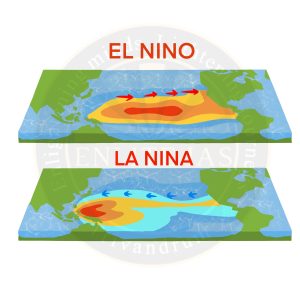Why in the news?
- Experts suggest that La Niña may lead to a colder winter in several parts of India, especially in the northern region. It may result in cold waves and increased snowfall in hilly regions.
La Nina
- What is it?: La Niña (means The Little Girl in Spanish) is a climatic phenomenon characterized by cooler-than-average sea surface temperatures in the central and eastern equatorial Pacific Ocean, along with some changes in atmospheric circulation. It’s essentially the opposite of El Niño.
- Mechanism of La Niña Formation:
- Strengthening of Trade Winds: Easterly trade winds blow more strongly than usual from South America → Indonesia.
- Warm-Water Displacement: These winds push warm surface water westwards, causing it to pile up near Australia and Indonesia.
- Upwelling of Cold Water: To replace the displaced warm water, cold nutrient-rich water upwells from the deeper ocean along the Peruvian and Ecuadorian coasts.
- Cooling of Eastern Pacific: The SSTs of the central and eastern tropical Pacific drop by ~0.5 °C or more below normal.
- Enhanced Walker Circulation: Rising motion over the warm western Pacific and sinking motion over the eastern Pacific intensify rainfall in Asia–Australia and suppress it near the Americas.
- Teleconnections: The altered circulation shifts the jet streams, influencing rainfall, temperature, and storm patterns worldwide.
- Global Impacts of La Niña:
- Generally leads to cooler global average temperatures than El Niño years.
- Associated with heavy rainfall and floods in parts of Southeast Asia, Australia, and South America, and drier conditions in the US west coast and eastern Africa.
- May increase Atlantic hurricane activity due to reduced vertical wind shear.
- Impact on India:
- Rainfall and Monsoon:
- It usually brings above-normal monsoon rainfall in India.
- Enhances southwest monsoon strength, leading to better kharif crop yields.
- Reduces the likelihood of droughts (in contrast to El Niño years).
- Temperature and Winter Conditions (2025–26):
- Expected to bring a colder-than-usual winter, especially in North India.
- Likely to cause cold waves and higher snowfall in Himalayan and hilly regions.
- Agriculture and Water Availability:
- Favors rabi sowing due to increased soil moisture from good monsoon rains.
- Could improve reservoir storage and groundwater recharge.
- However, Global Warming May Offset Cooling:
- The World Meteorological Organization (WMO) notes that despite La Niña, global mean temperatures remain above normal.
- Anthropogenic climate change is weakening traditional ENSO effects, altering expected rainfall and temperature patterns.
- Rainfall and Monsoon:

